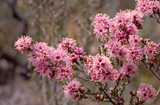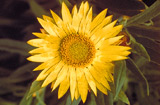|
[Front Page] [Features] [Departments] [SGAP Home Page] [Subscribe]

Butterfly Mania
Brian Faulkner
|

|
Butterflies conjure up visions of warmth, bright colours and energy. Indeed, what could be more symbolic of sunshine than a gorgeous Blue Triangle butterfly (Graphium sarpedon) dancing over the summer blossoms?
The good news is that butterflies are easy to attract to your garden if you grow the plants they like. In fact there is a rapidly developing branch of horticulture known as "butterfly gardening" that is becoming more and more popular. Devotees dedicate themselves to the art of cultivating gardens specifically for their local butterflies.
Be warned, though: once started on this path even the most sedate of personalities can end up as passionate fanatics!
The idea of deliberately encouraging leaf-eating caterpillars may seem strange at first, but there are two points to consider: most butterfly caterpillars inflict only minor damage and the beauty of the adult insects more than compensates for the loss of a few leaves.
Bleak winter nights present an ideal opportunity to plan for the coming butterfly season. There are various strategies commonly adopted by butterfly enthusiasts: the easiest one is to select a particular butterfly that you like and concentrate on this one species alone. Another strategy is to try to attract as many different species as possible, the challenge each year being to add to the list!
One of the keys to successful butterfly gardening lies in understanding the basic butterfly life cycle. This starts with an egg, which is usually laid on or near a carefully chosen plant. Out of the egg hatches a tiny caterpillar, which feeds on the leaves of the plant. If the plant is not suited to that butterfly species, either the caterpillar will not feed and will quickly starve to death, or if it does feed it will be poisoned by the plant and will die.
Because of this most female butterflies are extremely fussy in choosing where to lay their eggs and each species uses a very limited range of food plants. This means that if you wish to breed a particular species of butterfly, you need to grow the right larval food plants.
Assuming the egg was laid on or near an appropriate food plant and the caterpillar has successfully fed and grown to full size, the next stage is the pupal stage. Outwardly inactive, the pupa (or chrysalis) is internally a hot bed of metabolic activity as the basic body structure of the caterpillar is transformed into the final stage of the life cycle: the adult butterfly.
Adult butterflies are active creatures and need a good energy source. Most get it in the form of sugar-rich nectar from flowers, so as well as providing your butterflies with appropriate larval food plants it is a good plan to provide them with plenty of suitable flowers.
First of all you need to decide whether you are going to stick exclusively to Australian native plants or if you want to use a few exotics too. I have set myself the challenge of butterfly gardening only with Australian native plants, though many butterfly gardeners do use introduced butterfly favourites such as Lantana, Buddleia, Pentas, Ixora and Catharanthus.
Most native plant enthusiasts will already have a wide selection of plants that are good nectar sources for butterflies. Such plants typically produce abundant, nectar-rich, easily accessible flowers in massed inflorescences. Good examples can be found in the following genera: Angophora, Bursaria, Callistemon, Corymbia, Epacris, Eucalyptus, Grevillea, Kunzea, Leucopogon, Leptospermum, Melaleuca, Pimelea and Westringia.
 |
Angophora hispida (top) and Kunzea parvifolia (bottom) are two plants whose flowers contain abundant nectar.
Select a thumbnail image or plant name for a higher resolution image (49k and 33k, respectively).
|
 |
Gardens with a good range of Australian native plants will therefore attract many visits from the local butterflies. However the dedicated butterfly gardener will want them to stay and breed. To achieve this it is necessary to provide the appropriate larval food plants and this depends on what butterflies you have in your area and which ones you particularly wish to encourage. Since I am limited to space I can only mention a few of my favourite butterflies and their larval food plants. (Details of others can be found in the references provided).
One genus of introduced plants that has particular relevance to butterfly gardening is Citrus. If you have Citrus trees in your garden you will be regularly visited by two attractive butterflies that have adopted introduced Citrus species as larval food plants: the large black and white Orchard Swallowtails (Papilio aegeus) and the smaller black, grey and cream Dingy Swallowtails (Papilio anactus). Native larval food plants for these butterflies include various Microcitrus species and the Desert Lime (Eremocitrus glauca).
Most gardens have a wattle or two and these are larval food plants for many butterflies including the small but dazzling Fiery Jewel (Hypochrysops ignitus), the spectacular Tailed Emperor (Polyura pyrrhus sempronius) and the glowing Common Grass Yellow (Eurema hecabe).
Two common and very pretty butterflies are the Meadow Argus (Junonia villida) and the Australian Painted Lady (Vanessa kershawi). Meadow Argus butterflies will breed happily on Scaevola and Goodenia species. Painted Ladies use species of Asteraceae such as the Golden Everlasting (Bracteantha bracteata = Helichrysum bracteatum) and its many cultivars.
 |
The golden everlasting daisy, Bracteantha bracteata appeals to a range of butterflies.
Select the thumbnail image or plant name for a higher resolution image (51k).
|
Two of my favourites are the electric Blue Triangle Butterfly (Graphium sarpedon) and the elegant green Macleay's Swallowtail (Graphium macleayanum). For Blue Triangles I grow Oliver's sassafras (Cinnamomum oliveri) and for Macleay's Swallowtail I grow sassafras (Doryphora sassafras). Both of these are large trees in nature, but can be confined to large tubs. Regular pruning and light fertilising produce lots of fresh new shoots to entice egg laying female butterflies.
Finally I should also mention the Lesser Wanderer butterflies (Danaus chrysippus) and their larger relatives the Wanderers or Monarchs (Danaus plexippus). Also known as Milkweed butterflies because they utilise latex bearing Asclepiadaceae as their larval food plants, both of these beautiful orange and black butterflies are common around Sydney, breeding on an introduced weed: Gomphocarpus fruticosus. (I am still trying to find a suitable local native alternative and if anyone has any ideas I'd love to hear from you!).
 |
Wanderer Butterfly on a Callistemon (bottlebrush).
Select the thumbnail image or highlighted name for a higher resolution image (32k).
Photo: Densey Clyne
|
Danaus plexippus is a fairly recent addition to the Australian butterfly fauna, first being recorded in this country in 1871. Although the literature suggests that this species is entirely dependent on introduced plants, I have a hunch that it is able to utilise native Asclepiadaceae as larval food plants. The question is, which ones?!
The butterflies mentioned above are to be found in most areas of NSW, along with many other lovely species. Readers fortunate enough to be living in tropical areas will have a much greater range of species to choose from, but wherever you live there are beautiful butterflies in a range of sizes, shapes and colours.
I hope I have managed to whet your appetite and stimulate your interest in the art of "butterfly gardening"! It is easy, fun and very rewarding. Whether you are a serious Lepidopterist or merely dabbling in the art, you will never grow tired of the thrill of seeing a perfect, freshly emerged butterfly taking to the air for its first flight, its gorgeous colours glowing in the warm sunshine!
Further reading
-
Clyne, D. (1996 edition). How to Attract Butterflies to your Garden. Kangaroo Press, NSW.
- Common, I. F. B. and Waterhouse, D. F. (1981 revised edition). Butterflies of Australia. CSIRO Publications.
- D'Abrera, B. (1984). A Field Companion to the Butterflies of Australia and New Zealand. Five Mile Press, Victoria.
- Valentine, P, Frith, C. B. and Frith, D. W. (1988). Australian Tropical Butterflies. Frith and Frith Books, Queensland.
From the October 1997 issue of "Native Plants for New South Wales", the newsletter of the Australian Plants Society.

[Front Page] [Features] [Departments] [SGAP Home Page] [Subscribe]
Australian Plants online - September 1998
The Society for Growing Australian Plants
|